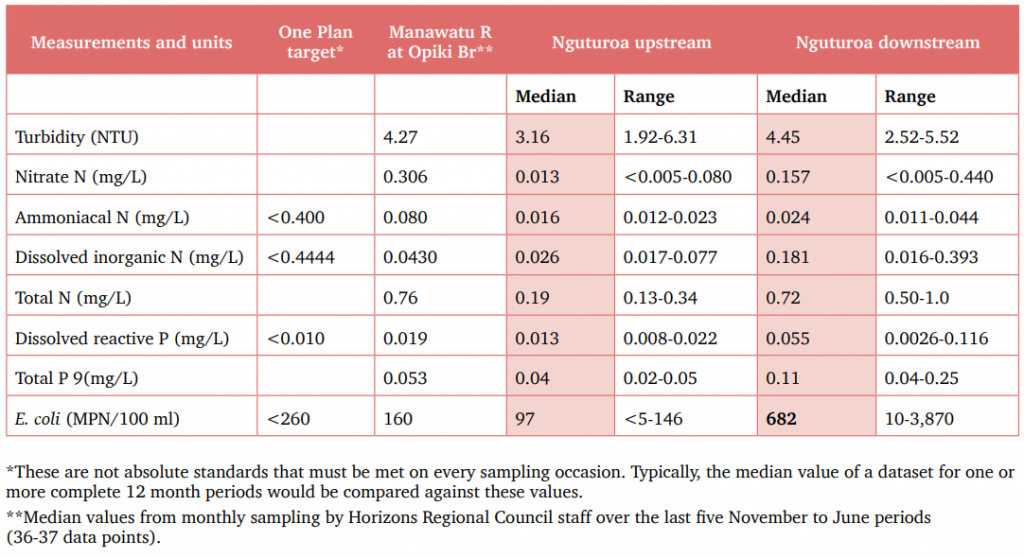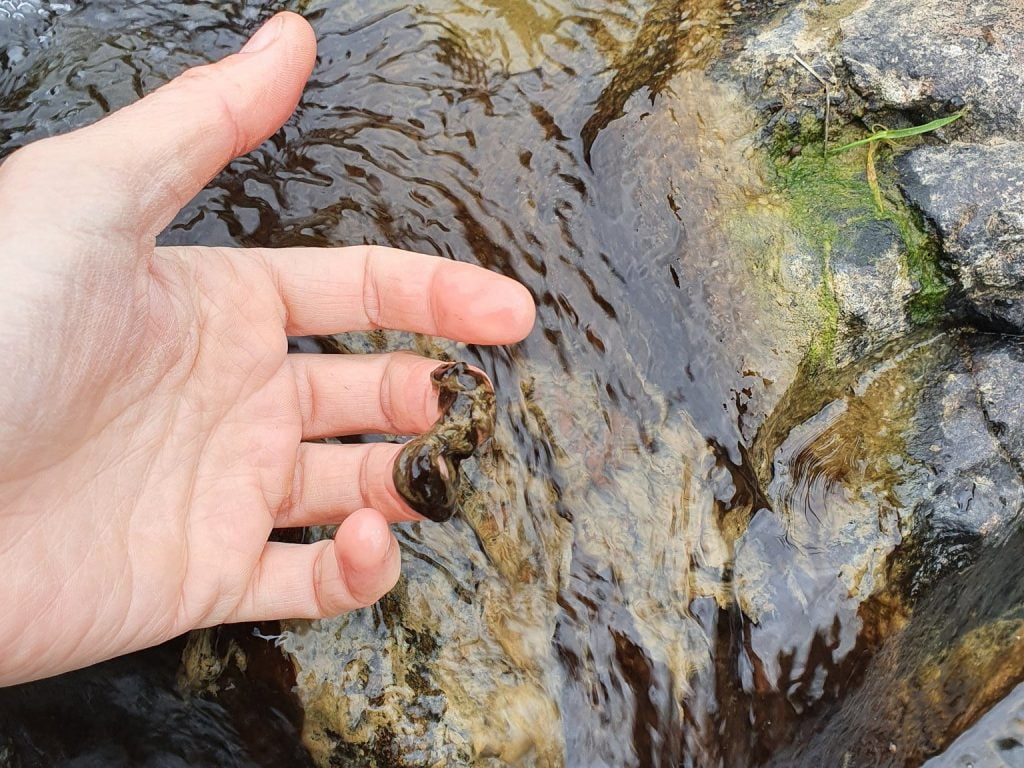Finding Out About Stream Health for Themselves
Manawatu catchment group members have investigated the ecological health of the stream they share and are tweaking their systems to look after it better.
Christine Finnigan jokes that her biggest contribution to a community project she initiated, centred around the Nguturoa Stream, was its name – Seeing, Understanding, Believing – but she says the title was fundamental to its success.
“If you see it and you do something about it, then see the result, you get buy-in. That was where we came from and that’s such an important aspect with practical people,” she says. “You can tell them till you’re blue in the face, but if they don’t see the result or the relevance or how it affects them, you know, out of sight out of mind, you’re not going to go anywhere.”
Christine joined fellow farmers, farm consultant Terry Parminter and NIWA scientists Juliet Milne and Amanda Valois, to find out what was happening in their stream, as opposed to what might be assumed to be as a result of farming.
Five years ago she bought a 160 ha property near Linton, at the foot of the Tararua Ranges, in partnership with her son James and daughter-in-law Hanna. Christine enjoyed the farm’s stand of native bush and became interested in starting a catchment group to look after the Nguturoa Stream which runs through her and her neighbours’ farms.
She tried to get her local DairyNZ discussion group interested, but when other members didn’t show much enthusiasm, she went ahead and started work herself and invited community members to a catchment meeting. To her surprise 30 people turned up. Christine found that despite the differing backgrounds of the group members they shared values around protecting and enhancing the catchment. The group didn’t have much knowledge about the stream’s ecological health, so they decided to undertake water testing. When she told Terry Parminter he saw the potential to show farmers what they could do themselves while also finding out something valuable about their waterway. He applied for funding from the Our Land and Water Rural Professionals Fund and contacted NIWA to get some expert scientific help.
Assessment kit
NIWA has developed a stream health monitoring and assessment kit (SHAMK). NIWA scientists and project team members Juliet Milne and Amanda Valois worked with three farmers to show them how to use the kit to build a picture of the health of the Nguturoa Stream. The kit tells you some, but not all, of the necessary information required to judge stream health. It was augmented by traditional water sampling for nitrogen and phosphorus species, sediment (as indicated by turbidity) and the faecal indicator bacteria E. coli.
Using the kit and water sampling, stream water quality and ecological conditions were measured at four sites on multiple occasions:
- At the top of the catchment where the stream begins
- At a drainage point for each of the farms where they enter the stream
- At the lower end of the catchment below all of the farms (see Table 1).

The expectation, from what is often reported in the media about livestock farming and water pollution, was that the tests would reveal high concentrations of nitrates in the stream water as a result of farming. However, what was revealed was that phosphorus, sediment and E. coli were more serious issues.
“You could assume our catchment was really high in nitrogen and then you could have spent a whole lot of money mitigating that when, in actual fact, the best thing we could have done is address critical source areas, or all the septic tanks up the road, or something like that. Knowing what you’ve got and then doing the right mitigations is really important because you can waste a lot of money,” says Christine.
As a result of the project, the three farmers involved are making management changes to reduce sediment and phosphorus run-off.
An important part of the project, Terry Parminter says, is empowering farmers to do the work themselves and not rely on regulators to tell them what to do. “Any farmers, any community, anywhere in New Zealand could do this and have some way of interpreting the results and linking them back to management. It’s about empowering, rather than making them dependent,” he says.
As a result of the project, the three farmers involved are making management changes to reduce sediment and phosphorus run-off. More fencing and riparian planting is planned, and one farmer will install a stock water supply so animals don’t need to drink from the stream, reducing deposits of faeces and E. coli. Another farmer is considering installing a wetland to trap phosphorus and pathogens.
Inter-connected ecology
As well as measuring water quality, the farmers and scientists examined what was living in the stream (invertebrates and fish) and looked closely at the freshwater mussels (kākahi) found on Christine’s farm. They found out that although the kākahi were there, there wasn’t any sign that the population was growing or spreading to other parts of the stream.
That turned out to be a lesson in how inter-connected different aspects of stream ecology are. Kākahi rely on their free-swimming larvae being able to attach to the gills of native kōaro (whitebait) to hitch a ride to new locations upstream, but if there are only a few of the fish around kākahi can’t spread.
The community agreed on the importance of supporting kāhaki in the stream, so are starting to look at culverts and other ways to help whitebait swim all the way up to the Nguturoa catchment from the sea. By minimising sediment, the group will also help the kākahi, which are filter feeders.

The expectation was that tests would reveal high concentrations of nitrates in the stream water as a result of farming. However, what was revealed was that phosphorus, sediment and E. coli were more serious issues.
Terry Parminter sees this as an example of how finding out what’s happening in their local stream has influenced farmer attitudes. “We’ve started to have farmers thinking about all of this and starting to change their management,” he says.
Involving farmers in hands-on water quality measurement led to them thinking more about what the numbers mean and reflecting on them as part of their day-to-day management.
Next steps
Terry Parminter believes an important role for rural professionals is ‘connecting the dots’ to ensure farmers make sense of the numbers coming from monitoring. “It’s hard to get excited and passionate about numbers, but turn it into animals and bugs and life in the stream and it starts to make more sense to people,” he says.
Rural professionals and farmers can connect those dots to decide on possible farm management changes and apply strategic thinking to include actions in a farm environment plan (FEP).
– Tony Benny for Our Land and Water National Science Challenge
Resources for measuring stream health:
- Find more information, a manual for use, and purchase a SHMAK kit from NIWA
- Instructional videos demonstrate the correct procedure for carrying out measurements using SHMAK, including the collection of water samples
- Our Land and Water has a repository of resources for catchment groups and catchment planning
More information:
- Rural Professionals Fund 2020-21
- Download PDF
- All text in this article is licensed for re-use under Creative Commons Attribution 4.0 International (CC BY 4.0)
Author
 View Our Strategy Document 2019 – 2024
View Our Strategy Document 2019 – 2024




Leave a Reply